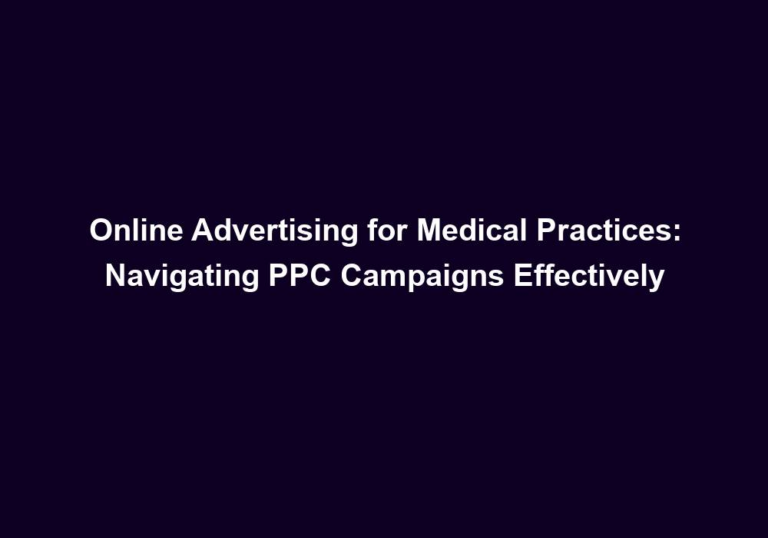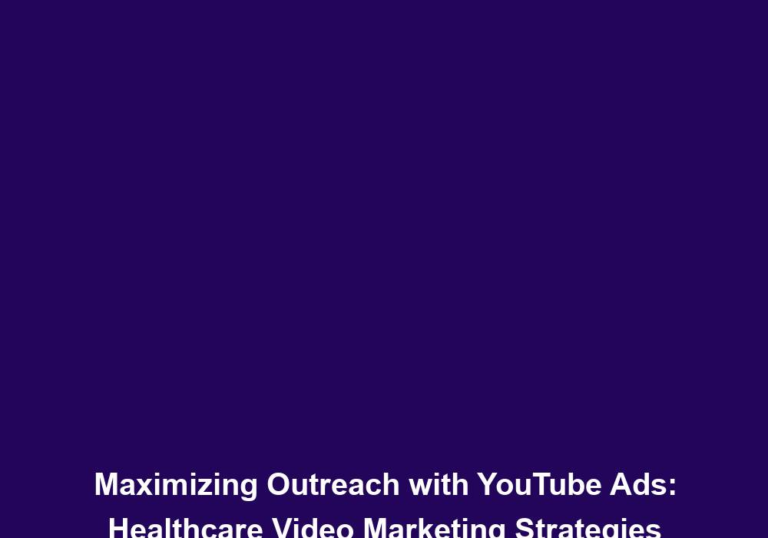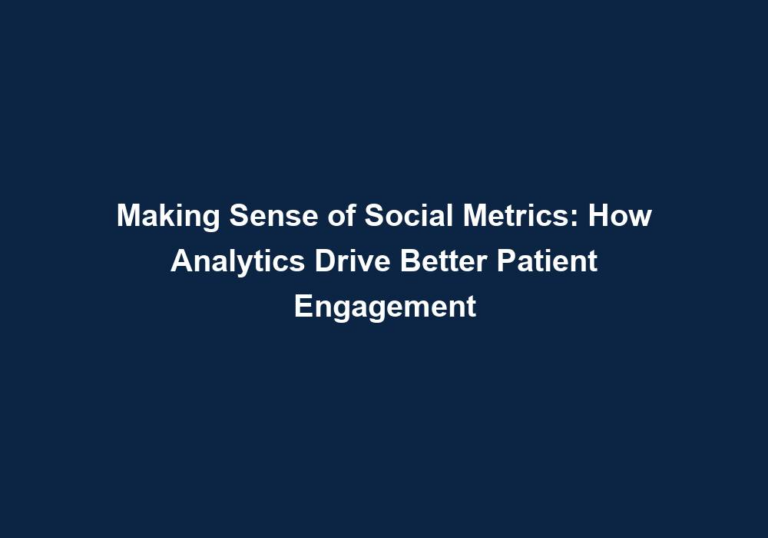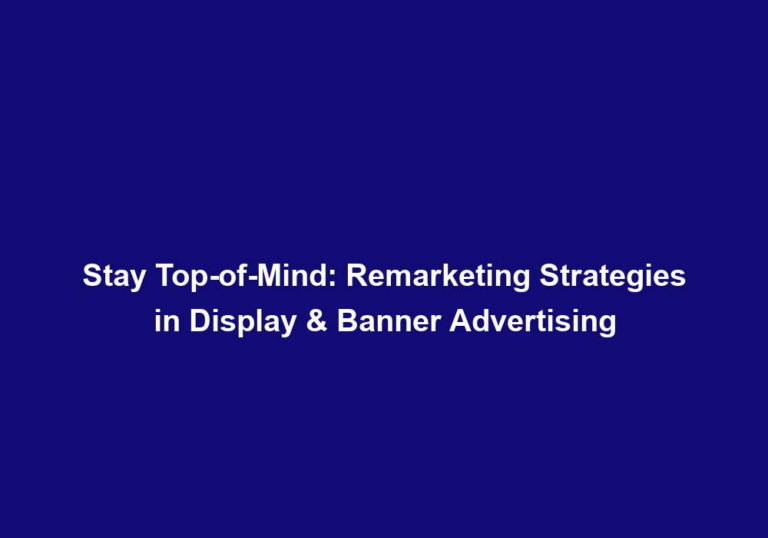Online Advertising Blueprint for Healthcare Professionals: Digital Marketing Best Practices
In today’s digital age, online advertising has become an essential tool for businesses to reach their target audience and achieve their marketing goals. With the rapid advancements in technology and the increasing prevalence of internet usage, it has become crucial for professionals to understand and implement effective digital marketing strategies. This article aims to provide a comprehensive blueprint for professionals looking to enhance their online advertising efforts and maximize their return on investment (ROI).
Why Online Advertising Matters for Professionals
Before delving into the best practices of online advertising, it is important to understand why it matters for professionals. Online advertising allows professionals to broaden their reach and connect with potential clients or customers in a cost-effective manner. It provides a platform to showcase their expertise, build brand visibility, and generate leads. In this highly competitive digital landscape, professionals who ignore online advertising are at a disadvantage, missing out on valuable opportunities to grow their business.
Benefits of Online Advertising for Professionals
-
Increasing brand awareness: Online advertising enables professionals to enhance their visibility and recognition among their target audience. By strategically placing ads, professionals can ensure that their brand is seen by potential clients or customers, increasing the chances of being top-of-mind when they are ready to make a purchase or seek professional services.
-
Generating leads: Online advertising offers professionals the opportunity to attract potential clients or customers and capture their information. By utilizing lead generation forms or landing pages, professionals can collect valuable data that can be used for future marketing efforts. This allows professionals to build a database of potential leads and nurture relationships over time.
-
Driving website traffic: An effective online advertising campaign can drive more visitors to a professional’s website, providing an opportunity to showcase their services or products. By directing targeted traffic to specific landing pages or service pages, professionals can increase the chances of conversion and ultimately grow their business.
-
Promoting specific events or offers: Online advertising is an excellent way to create buzz and drive engagement for particular campaigns, events, or offers. By targeting the right audience with compelling ads, professionals can generate excitement and encourage action, leading to increased participation or sales.
-
Establishing thought leadership: Professionals can position themselves as industry experts by leveraging online advertising to share valuable content. By creating and promoting informative articles, blog posts, or videos, professionals can establish credibility and become a trusted source of information in their respective fields.
Clearly defining your advertising goals will serve as a guiding principle throughout your campaign, ensuring that your efforts are focused and aligned with your overall business objectives.
Understanding Your Target Audience
To effectively advertise online, professionals must have a deep understanding of their target audience. Conducting thorough market research and creating detailed buyer personas will enable you to tailor your messaging and choose the most appropriate advertising channels. Consider the following factors when analyzing your target audience:
- Demographics: Age, gender, location, education level, and income. Understanding these demographic factors will help professionals create targeted ads that resonate with their specific audience segments.
- Interests and behaviors: Hobbies, online activities, and purchasing patterns. By understanding the interests and behaviors of their target audience, professionals can craft ads that align with their preferences and capture their attention.
- Pain points and challenges: Identifying the problems your target audience is trying to solve. By addressing these pain points in your ads, professionals can position themselves as the solution and connect with their audience on a deeper level.
Once you have a clear understanding of your target audience, you can create highly targeted and relevant advertisements that resonate with them, resulting in higher engagement and conversion rates.
Choosing the Right Advertising Channels
With a plethora of digital advertising channels available, professionals need to carefully select the most suitable platforms for their campaigns. Here are some popular advertising channels to consider:
1. Search Engine Advertising
Search engine advertising, such as Google Ads, allows professionals to display targeted ads to users who are actively searching for relevant keywords. This channel offers excellent visibility and the ability to track and measure performance through analytics. By utilizing keyword research and optimizing ad campaigns, professionals can ensure that their ads appear in front of their target audience at the right time.
2. Social Media Advertising
Social media platforms, such as Facebook, Instagram, LinkedIn, and Twitter, provide powerful advertising opportunities to professionals. These platforms offer advanced targeting options based on demographics, interests, and behaviors, allowing you to reach your ideal audience effectively. By creating engaging and visually appealing ads, professionals can leverage the vast user base of social media platforms to increase brand awareness, generate leads, and drive website traffic.
3. Display Advertising
Display advertising involves the placement of visual or interactive ads on websites, blogs, and other online platforms. This channel provides excellent brand exposure and can be utilized for both direct response and brand awareness campaigns. By selecting relevant websites or online publications that align with their target audience, professionals can reach a broader audience and increase their brand visibility.
4. Video Advertising
Video advertising, through platforms like YouTube or TikTok, has gained immense popularity due to its engaging and interactive nature. Videos can be used to showcase tutorials, testimonials, or simply to create brand awareness. By creating compelling and informative videos, professionals can capture the attention of their target audience and deliver their message in a visually appealing format.
5. Email Marketing
Email marketing remains a powerful tool for professionals, allowing them to directly communicate with their audience. By building a targeted email list, professionals can share valuable content, promote offers, and nurture relationships with potential clients or customers. Email marketing can be highly personalized and tailored to specific segments, ensuring that the right message reaches the right audience at the right time.
Choosing the right advertising channels depends on factors such as your target audience, budget, and campaign goals. It is important to analyze the strengths and weaknesses of each channel and test different strategies to determine what works best for your specific needs.
Crafting Compelling Advertisements
Effective advertisements are the cornerstone of successful online advertising campaigns. Here are some tips for crafting compelling ads:
- Use attention-grabbing headlines and compelling visuals to capture the viewer’s interest. A catchy headline and visually appealing imagery can make your ad stand out from the competition and entice users to click.
- Clearly communicate the value proposition and benefits of your services or products. Highlight the unique selling points of your offerings and explain how they can solve your audience’s problems or fulfill their needs.
- Incorporate persuasive calls-to-action to prompt the desired response from your audience. Whether it’s encouraging them to sign up for a free trial, make a purchase, or contact you for more information, a strong call-to-action can drive action and increase conversion rates.
- Tailor your messaging to resonate with your target audience’s pain points and aspirations. Show empathy and understanding of their challenges, and position your offerings as the solution they’ve been searching for.
- Test different ad variations to identify the most successful combinations. A/B testing different headlines, visuals, and ad copy can help you optimize your ads and improve their performance over time.
Remember, your ads should be concise, engaging, and deliver a clear message that drives action from your audience.
Tracking and Optimizing Performance
Tracking and analyzing the performance of your online advertising campaigns is crucial to optimize your strategies and achieve better results. Here are some key metrics to monitor:
- Click-through Rate (CTR): Measures the percentage of users who click on your ad after seeing it. A high CTR indicates that your ad is compelling and resonating with your audience.
- Conversion Rate: Indicates the percentage of users who take the desired action, such as making a purchase or filling out a form. A high conversion rate shows that your ad is effectively driving desired outcomes.
- Return on Ad Spend (ROAS): Calculates the revenue generated for every dollar spent on advertising. ROAS helps you measure the profitability of your campaigns and make informed decisions about budget allocation.
- Cost per Acquisition (CPA): Determines the cost of acquiring a single customer or lead. By tracking CPA, professionals can evaluate the efficiency of their campaigns and optimize their budget allocation.
- Bounce Rate: Measures the percentage of users who leave your website without taking any further action. A high bounce rate may indicate that your landing page or website needs improvement.
By regularly monitoring these metrics and making data-driven adjustments, professionals can optimize their campaigns, improve their ROI, and ensure that their advertising efforts are delivering the desired results.
Conclusion
Online advertising has become an indispensable tool for professionals seeking to enhance their visibility, attract clients or customers, and grow their business. By defining clear advertising goals, understanding the target audience, choosing the right advertising channels, crafting compelling advertisements, and tracking performance, professionals can create successful online advertising campaigns that generate tangible results. Embracing these best practices will empower professionals to navigate the dynamic digital landscape and effectively promote their expertise to a wider audience.







